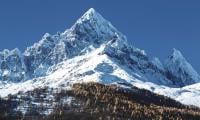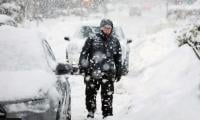Crabbing in mangroves no better than fishing in troubled waters
HYDERABAD: It is true that rough seas make good sailors but they also make bad fishermen as hostile weather conditions not only make it impossible for the latter to catch their livelihoods but also pose a risk to their lives.
The changing sea weather patterns, rising mercury, and strong winds have forced marine fishermen to moor their vessels at traditional jetties in Sindh coastal areas of Thatta, Sujawal and Badin districts. This time the conditions took a turn for the worse in the month of May rather than June and July, disrupting fishing activities. The fisherfolk fears they may have to sit idle for three months (May-July) without work.
There are around 7000 fishing vessels of all sizes, employing a large number of crew members, residing at Keti Bunder, Kharo Chhan, Shah Bunder, Jati, Sakro, Bhanbhor, Ghro and other fishing zones, who face vulnerability. Senior fishermen believe the sea level is rising due to receding river water, which has put boats and crew members exposed to face the open sea winds. Hence, many of them are reluctant to take risk and dock their boats.
Reports gathered from the affected areas reveal that only in Keti Bunder main jetty and other fish landing sites, around 1200 boats operate for catch. Likewise, in Kharo Chhan more than 700 boats take crews daily, which now are returning back to their jetties.
During rough sea and heat, the commercial fish species move to bottom and mostly fishermen return empty handed. Besides wasting time, they face losses of ration, fuel and ice. Usually, the government imposes ban on fishing during the breeding season of some commercial fish species. However, this new weather phenomenon has created challenges for the community as only along Sindh's 350 km long coast the livelihoods of roughly 0.2 million people depend on fishing.
During the off-season, some young fishermen opt to catch crabs in the mangroves fields to make both ends meet. “People travel long distance, wading through water in mangroves and vegetation fields to catch crabs. Each person catches at least three to four crabs weighing between 200 grams and 300 grams to earn a little amount daily,” Usman Lohar, a community activist from Kharo Chhan, said.
During the summer, the price of a live crab ranges from Rs200 to Rs300, depending on the size and health of the catch. The prices go up to Rs500-700 per item in the winter season. Presently, the community activists estimate that the main markets Kharo Chhan, and Keti Bunder jetties receive around 300-400 crabs each for market daily.
“Crabs are a winter season product and local traders usually set up centers near major jetties to purchase crabs from fishermen and supply them to urban markets,” Zahid Kalmati, another community activist of Kharo Chhan told The News.
There is a supply chain of these marine products in each season. Mud crabs are considered among the most valuable crab species in the world, with the bulk of their commercial production marketed live.
In the season, mostly in January and February, a 300 gram crab is valued at Rs300 to Rs1,000. Sometimes in the season, farmers sell crabs costly, from Rs500 to Rs2,500 in the urban market, earning better livelihoods.
Also, the season of delicious Palla (Hilsa) begins in May, but fishermen believe due to unavailability of fresh water from the River Indus flowing into the sea, Palla does not travel upstream. Out of desperation, some fishermen along the creeks catch juvenile Palla against the advice of the elders. For the last many years, this fish has almost vanishing from the Indus river due to water shortage.
Recalling the past, senior fishermen said that in 1960 and later a traditional small boat used to bring 1200-2000 Pallas daily from the river and the fish was the main export item in those days. “But now fishermen are unable to catch even a single palla from downstream Kotri as there is no more water in the river,” he added.
-
 Hayden Panettiere Reveals Go To Tool For Battling Emotinional Toll Of Roles
Hayden Panettiere Reveals Go To Tool For Battling Emotinional Toll Of Roles -
 Birmingham Turns Pink: Watch Mysterious Pink Sky During Snowstorm
Birmingham Turns Pink: Watch Mysterious Pink Sky During Snowstorm -
 Kendall Jenner Tells 'truth' About Whether She Has Had Plastic Surgery
Kendall Jenner Tells 'truth' About Whether She Has Had Plastic Surgery -
 Chris Pratt Reveals Odd Gift Arnold Schwarzenegger Gave Him And Wife Katherine
Chris Pratt Reveals Odd Gift Arnold Schwarzenegger Gave Him And Wife Katherine -
 King Charles Views Kate Middleton As 'great Asset' For Royal Family
King Charles Views Kate Middleton As 'great Asset' For Royal Family -
 Britney Spears Shares Bombshell Reason About Dancing On Social Media
Britney Spears Shares Bombshell Reason About Dancing On Social Media -
 A Red Pixel In The Snow: How AI Helped To Crack The Mystery Of A Missing Mountaineer
A Red Pixel In The Snow: How AI Helped To Crack The Mystery Of A Missing Mountaineer -
 Denise Richards, Aaron Phypers’ Divorce Takes Dark Turn: 'Not Flush With Cash'
Denise Richards, Aaron Phypers’ Divorce Takes Dark Turn: 'Not Flush With Cash' -
 How To Survive Snowstorm: Essentials Preps, Travel Guide, Driving Tips Explained
How To Survive Snowstorm: Essentials Preps, Travel Guide, Driving Tips Explained -
 Ariana Grande Awaits Ethan Slater Proposal Amid Baby Fever?
Ariana Grande Awaits Ethan Slater Proposal Amid Baby Fever? -
 Billy Bob Thornton's Marriage To Connie Angland Faces Trouble Due To Angelina Jolie
Billy Bob Thornton's Marriage To Connie Angland Faces Trouble Due To Angelina Jolie -
 Grok Restricts AI Tools To Paid Users After Deepfakes Of Women And Children Sparks Outrage
Grok Restricts AI Tools To Paid Users After Deepfakes Of Women And Children Sparks Outrage -
 Apple CEO Tim Cook Reportedly Plans To Step Down
Apple CEO Tim Cook Reportedly Plans To Step Down -
 Orlando Bloom Must 'up His Game' Amid Sofia Vergara Romance Rumours
Orlando Bloom Must 'up His Game' Amid Sofia Vergara Romance Rumours -
 Meghan Trainor's Husband Daryl Sabara Responds To Ashley Tisdale's Mom Group Comments
Meghan Trainor's Husband Daryl Sabara Responds To Ashley Tisdale's Mom Group Comments -
 Gunnar, Matt Nelson Ready To 'set The Record Straight' On Their Dad Ricky's Tragic Death
Gunnar, Matt Nelson Ready To 'set The Record Straight' On Their Dad Ricky's Tragic Death



